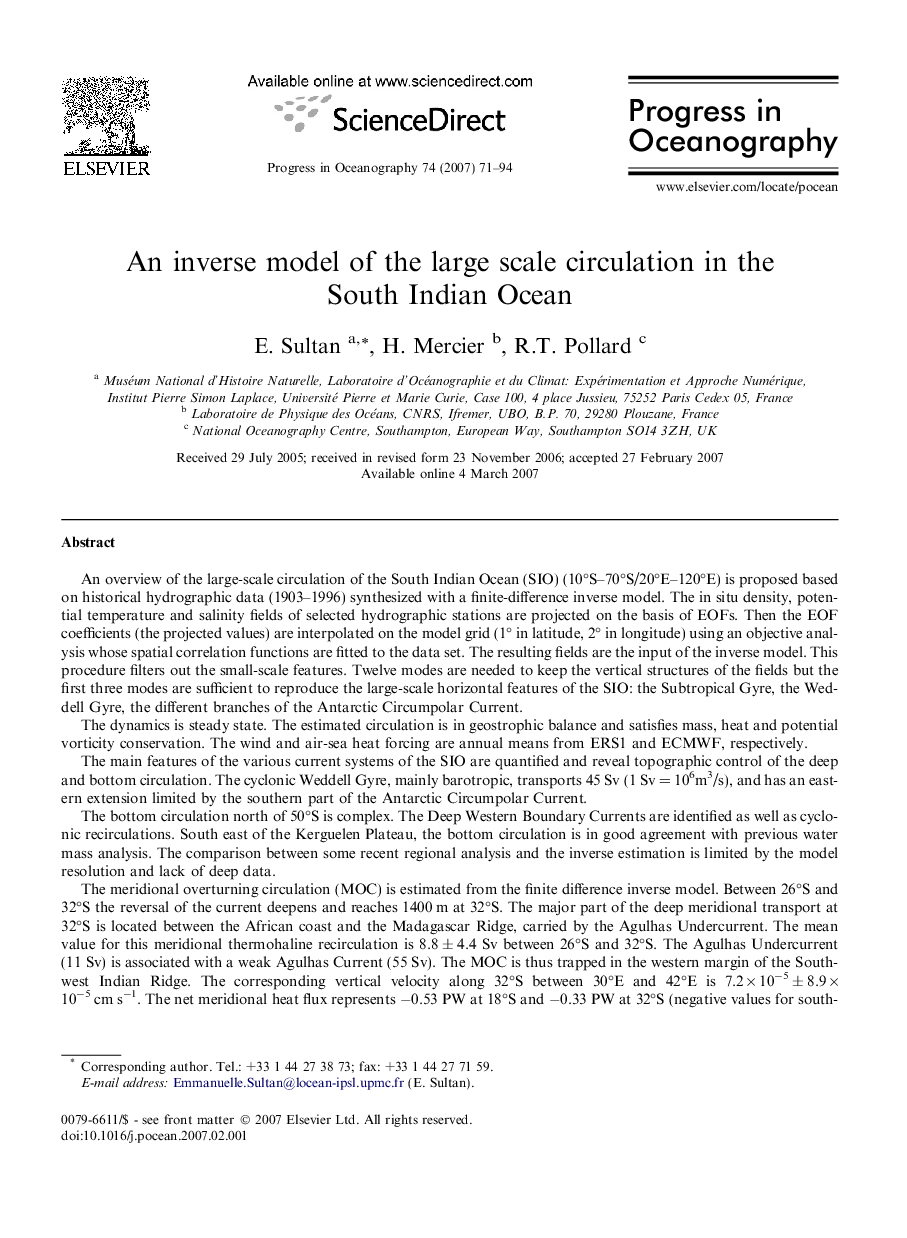| کد مقاله | کد نشریه | سال انتشار | مقاله انگلیسی | نسخه تمام متن |
|---|---|---|---|---|
| 4553770 | 1328928 | 2007 | 24 صفحه PDF | دانلود رایگان |

An overview of the large-scale circulation of the South Indian Ocean (SIO) (10°S–70°S/20°E–120°E) is proposed based on historical hydrographic data (1903–1996) synthesized with a finite-difference inverse model. The in situ density, potential temperature and salinity fields of selected hydrographic stations are projected on the basis of EOFs. Then the EOF coefficients (the projected values) are interpolated on the model grid (1° in latitude, 2° in longitude) using an objective analysis whose spatial correlation functions are fitted to the data set. The resulting fields are the input of the inverse model. This procedure filters out the small-scale features. Twelve modes are needed to keep the vertical structures of the fields but the first three modes are sufficient to reproduce the large-scale horizontal features of the SIO: the Subtropical Gyre, the Weddell Gyre, the different branches of the Antarctic Circumpolar Current.The dynamics is steady state. The estimated circulation is in geostrophic balance and satisfies mass, heat and potential vorticity conservation. The wind and air-sea heat forcing are annual means from ERS1 and ECMWF, respectively.The main features of the various current systems of the SIO are quantified and reveal topographic control of the deep and bottom circulation. The cyclonic Weddell Gyre, mainly barotropic, transports 45 Sv (1 Sv = 106m3/s), and has an eastern extension limited by the southern part of the Antarctic Circumpolar Current.The bottom circulation north of 50°S is complex. The Deep Western Boundary Currents are identified as well as cyclonic recirculations. South east of the Kerguelen Plateau, the bottom circulation is in good agreement with previous water mass analysis. The comparison between some recent regional analysis and the inverse estimation is limited by the model resolution and lack of deep data.The meridional overturning circulation (MOC) is estimated from the finite difference inverse model. Between 26°S and 32°S the reversal of the current deepens and reaches 1400 m at 32°S. The major part of the deep meridional transport at 32°S is located between the African coast and the Madagascar Ridge, carried by the Agulhas Undercurrent. The mean value for this meridional thermohaline recirculation is 8.8 ± 4.4 Sv between 26°S and 32°S. The Agulhas Undercurrent (11 Sv) is associated with a weak Agulhas Current (55 Sv). The MOC is thus trapped in the western margin of the Southwest Indian Ridge. The corresponding vertical velocity along 32°S between 30°E and 42°E is 7.2 × 10−5 ± 8.9 × 10−5 cm s−1. The net meridional heat flux represents −0.53 PW at 18°S and −0.33 PW at 32°S (negative values for southward transports). The intensity of the meridional heat flux is linked to the intensity of the Agulhas Current and to the vertical mixing.
Journal: Progress in Oceanography - Volume 74, Issue 1, July 2007, Pages 71–94